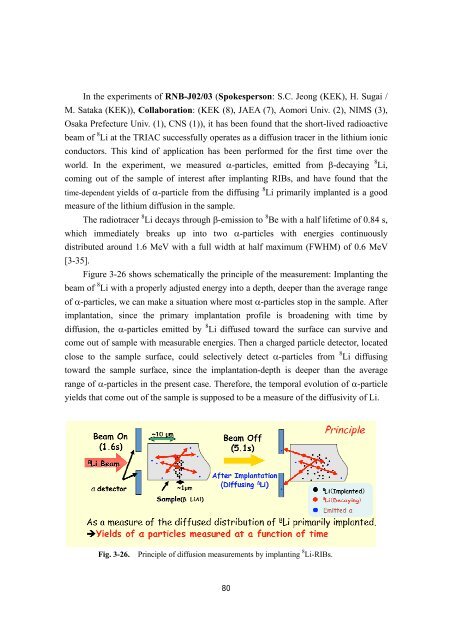TRIAC Progress Report - KEK
TRIAC Progress Report - KEK
TRIAC Progress Report - KEK
Create successful ePaper yourself
Turn your PDF publications into a flip-book with our unique Google optimized e-Paper software.
In the experiments of RNB-J02/03 (Spokesperson: S.C. Jeong (<strong>KEK</strong>), H. Sugai /<br />
M. Sataka (<strong>KEK</strong>)), Collaboration: (<strong>KEK</strong> (8), JAEA (7), Aomori Univ. (2), NIMS (3),<br />
Osaka Prefecture Univ. (1), CNS (1)), it has been found that the short-lived radioactive<br />
beam of 8 Li at the <strong>TRIAC</strong> successfully operates as a diffusion tracer in the lithium ionic<br />
conductors. This kind of application has been performed for the first time over the<br />
world. In the experiment, we measured α-particles, emitted from β-decaying 8 Li,<br />
coming out of the sample of interest after implanting RIBs, and have found that the<br />
time-dependent yields of α-particle from the diffusing 8 Li primarily implanted is a good<br />
measure of the lithium diffusion in the sample.<br />
The radiotracer 8 Li decays through β-emission to 8 Be with a half lifetime of 0.84 s,<br />
which immediately breaks up into two α-particles with energies continuously<br />
distributed around 1.6 MeV with a full width at half maximum (FWHM) of 0.6 MeV<br />
[3-35].<br />
Figure 3-26 shows schematically the principle of the measurement: Implanting the<br />
beam of 8 Li with a properly adjusted energy into a depth, deeper than the average range<br />
of α-particles, we can make a situation where most α-particles stop in the sample. After<br />
implantation, since the primary implantation profile is broadening with time by<br />
diffusion, the α-particles emitted by 8 Li diffused toward the surface can survive and<br />
come out of sample with measurable energies. Then a charged particle detector, located<br />
close to the sample surface, could selectively detect α-particles from 8 Li diffusing<br />
toward the sample surface, since the implantation-depth is deeper than the average<br />
range of α-particles in the present case. Therefore, the temporal evolution of α-particle<br />
yields that come out of the sample is supposed to be a measure of the diffusivity of Li.<br />
Fig. 3-26. Principle of diffusion measurements by implanting 8 Li-RIBs.<br />
80













